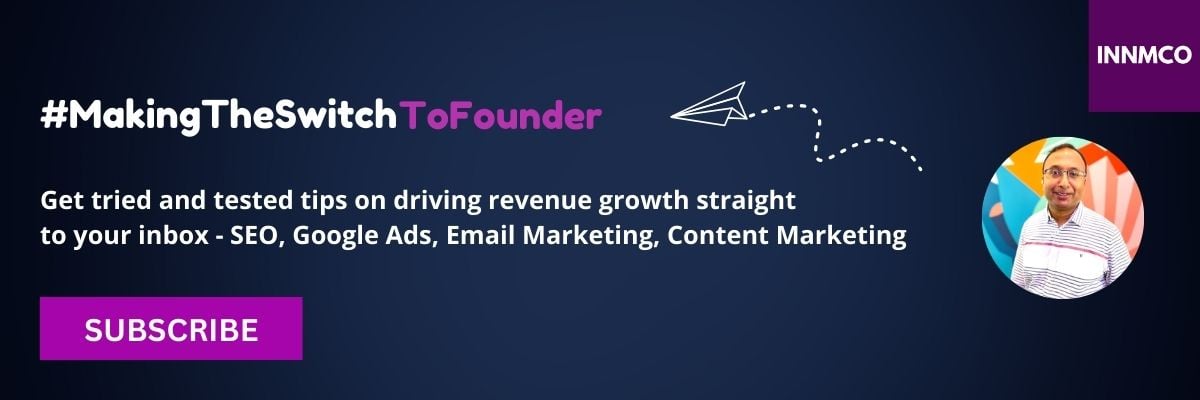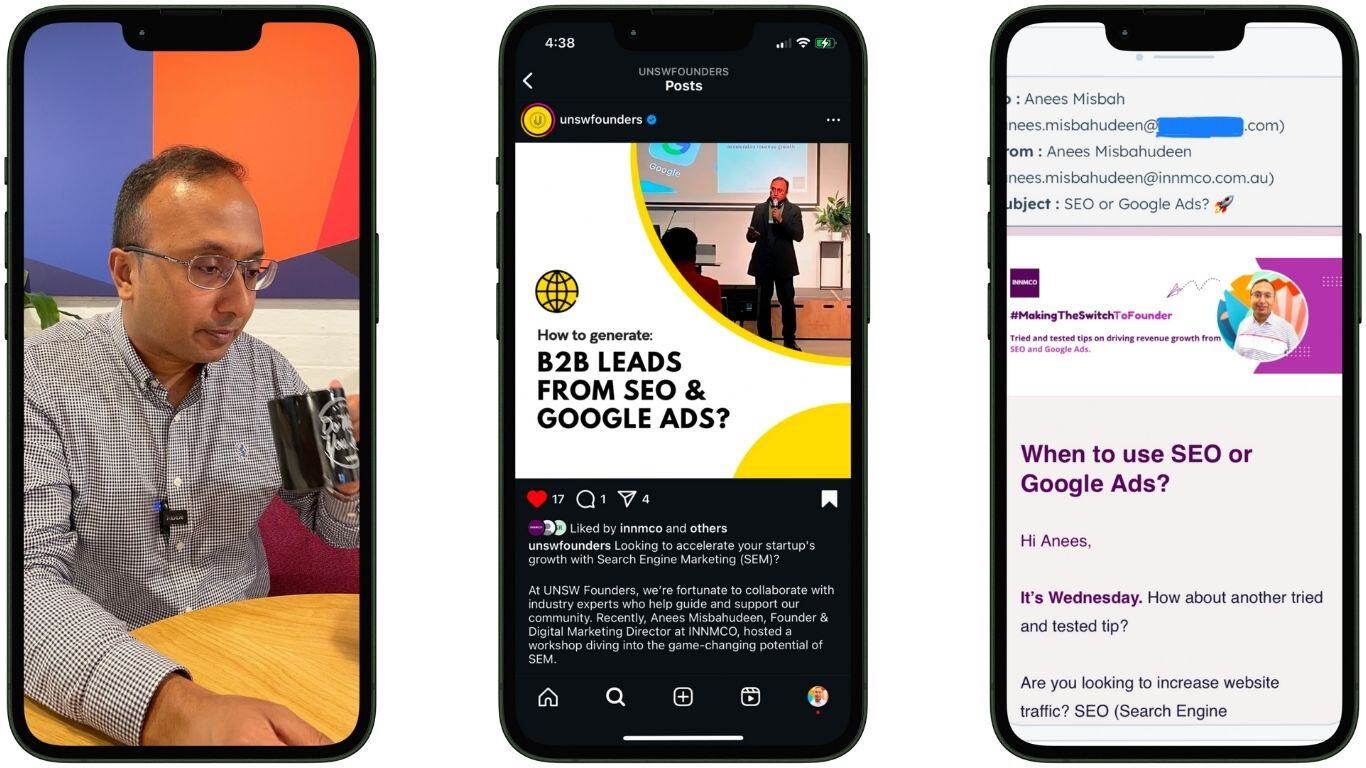Updated on: September 15, 2025
Struggling to generate leads?
I am an accidental entrepreneur!
I founded INNMCO during the autumn of 2021.
The pandemic was impacting people, businesses and livelihood.
Many businesses faced an existential crisis because they were not visible online or doing business online. This meant, few to no leads coming into the business.
How can you get inbound leads for your business?
Answer: Digital marketing campaigns! 😀
My approach to running digital marketing campaigns has always been prototype, test, learn and iterate.
Over time, I accumulated marketing strategies and techniques that worked for me.
In this blog, I want to share with you 8 steps you need to consider, to open the flood gates of leads coming into your business.
8 ways to generate leads for your business
1. Create a digital marketing strategy
Before planning social media campaigns and ad campaigns, you need to:
1. Research your target audience. The insights you learn about your target audience will help you guide your buyer through each stage of the buyer’s journey using the most effective marketing channel.
2. Set meaningful goals (short term, medium term and long term).
3. Select the most effective marketing channel:
- Review your existing content across marketing channels to analyse gaps.
- Based on your assessment, decide which channels to focus on.
- What content and campaigns do you want to run on those channels?
- How to allocate your budget across channels?
Once you have a digital marketing strategy in place, start creating content to implement your marketing campaigns and advance your marketing goals.
Your marketing goals must support movement of your target audience through the buyer’s journey. Campaigns can include everything from video messages, blogs, email templates, ads and banner images.
Lastly, create a plan to measure and analyse the results. This will give you data on, how to improve in the future.
2. Create a website
Create a website to inform your target audience, on what solutions you offer to address their needs.
There are multiple content management systems (CMS) and website builder tools that require little to no coding, to create a website.
These website tools have drag and drop capabilities. You can drag and drop page components to design a web page or you could choose a website template from a template library.
Based on our experience, you need to consider the below factors while shortlisting a Content Management System for your business:
1. Your CMS needs to have the capability to create web pages, blogs, landing pages and forms.
2. Your CMS should have the capability to sent leads to a CRM.
3. CMS integration with email marketing software to nurture leads generated from your website, blogs and landing pages.
4. CMS integration with a marketing automation tool to nurture leads generated from your website, blogs and landing pages via automated email sequences and customer journeys.
5. Price of the CMS.
3. Create a content marketing strategy
Once you have selected a content management system for your website. You need to start thinking about your content strategy.
Your prospective buyers consume content from the internet to find solutions to their problems. Create content that addresses their needs, challenges and goals.
Based on our experience, you need to consider the below steps, while creating a content marketing strategy:
1. Do buyer research. This will provide insights on how your target audience consumes content to address their needs.
2. Identify marketing channels. This will enable you to find the right channels (e.g. SEO, Google Ads, social media, email, online directories, influencer marketing, word of mouth) to distribute your content (e.g. blog posts, guest posting).
3. Identify content types. This will help you to find content types (e.g. blogs, videos, webinars, events, trade shows) that best resonate with your prospective buyer.
4. Create content. Create useful content to generate engagement from your content marketing efforts.
4. Be found in search
Once your website is up and running, you need to improve your content visibility in google search results.
Most buyers begin their buyer’s journey in Google Search. Your web content needs to be written in a way that includes keywords your target audience searches for in Google. You can distribute your content in Google Search by optimising your web pages in Google Search and Google Ads.

Image: Google’s AI overviews (search results) for the search term ‘What is SaaS marketing’
At the very least, create a business profile in google. Your services and contact details will be visible, when your target audience searches for your company.
Another way to increase your visibility in search is by running Search Ads (via the Google Ads platform). This will help you gain quick visibility with your target audience who are actively searching for solutions to address their needs.
By the way, if you are looking to create content that ranks, check out our on-demand content writing services and search engine marketing services and book a discovery call. Our clients have seen a 600% increase in leads in the first 6 months.
5. Publish consistently on social media
Distribute content using social media channels. This will help you build brand awareness and generate leads for your business.
You can reach your target audience using organic and paid social media. Organic social media is any content that you can share for free on social media platforms. Paid social media is when an advertiser pays a social media platform (e.g. LinkedIn), to run targeted ads.
You can generate leads via organic social media by using landing pages along with your social media posts. A few ideas for landing pages include webinar sign ups, free trials, newsletter sign ups etc.
Here’s how you can create a social media marketing strategy:
1. Find out which social media accounts are used by your target audience.
2. Write and post content (e.g. blog posts, case studies) to address the needs of your target audience. This will drive traffic to your website.
3. Create a content calendar. Schedule content (e.g. blog posts, case studies) using social media scheduling tools such as Hootsuite, HubSpot, Buffer etc.
6. Engage prospective buyers using emails
Email marketing involves sending personalised emails to prospective buyers with the objective of nurturing leads and converting leads into paying customers.
Your lead may not be ready to make a purchase. Engage your leads by creating and sending email campaigns at regular intervals using email marketing tools such as HubSpot.
Your target audience has to sift through hundreds of emails. Keeping your email content to one goal and one message will help them understand the intent of your email. This will enable them to take action.
If you need help writing effective emails that convert, check out our email marketing and marketing automation services using HubSpot and book a discovery call. Our clients have seen a 130% increase in open rate and 27% increase in CTR.

Image: Our monthly newsletter #MakingTheSwitchToFounder. Tried & tested tips on digital marketing campaigns.
Here’s what you need to consider while engaging prospective buyers using emails:
1. Create lead magnets to build a mailing list. Examples of lead magnets include events, webinars and gated content such as reports.
2. Segment your leads. This allows you to create personalised emails for different customer segments.
3. Prototype and test your subject line, email content and email layout to improve email open rates and click through rates.
4. Keep your prospective buyers and existing customers updated on the latest offers or insights that your company publishes.
5. Include call to actions that will prompt them to take action.
7. Organise leads in a CRM
Establish a customer relationship management (CRM) system. This will enable you to organise leads generated from multiple digital marketing campaigns and channels.
Most CRMs have the capability to organise leads by contacts, companies and deals:
1. Contacts: Add contacts to your CRM. Organise existing conversations with prospective buyers. A centrally located list of contacts in a CRM helped me organise my leads and manage duplicate contacts, as I started to generate leads from multiple campaigns.
2. Companies: Associate company details to your leads. Pick a CRM that automatically pre-fills company details and logo from an external data source. This saves time, as you don’t have to manually enter this information in every company record.
3. Deals: Set up deals and deal stages. A deal is typically associated with a contact and a company. Deals and deal stages help me track potential opportunities in my sales pipeline and their progress towards completion.
8. Choose an integrated sales and marketing technology stack
Marketing technologies will help you maintain buyer personas, record leads, segment leads, nurture leads and record the progress of your marketing campaigns.
A marketing technology stack includes tools such as Search Engine Optimisation tools (e.g. Google search console, SEMrush), Search Engine Marketing tools (Google Search Ads), Social media management tools (e.g. Hootsuite, SproutSocial), Website (e.g. HubSpot CMS hub, Wordpress, Drupal), email marketing software (e.g. HubSpot Marketing hub), graphic design (Canva) etc.
A sales technology stack includes tools such as a Customer Relationship management (CRM) software. This will help you forecast sales, track sales opportunities and manage the customer lifecycle in a CRM.
It can become quite cumbersome to log into multiple tools for website management, landing page creation, lead generation and lead nurture.
This is because multiple tools creates information siloes. This makes it difficult to get a single view of your buyer’s / customer’s interaction with your business.
Hence, it’s recommended to choose an integrated sales and marketing technology stack. This will give you more time to focus on marketing activities.
Conclusion
Struggling to generate leads for your business?
Create an online presence for your business.
Consider popular digital channels like website, search and social media to generate leads.
Use emails to nurture leads and convert leads into paying customers.
Organise leads in a CRM.
Choose an integrated sales and marketing technology stack. In this way, you get to focus more on marketing activities that enable you to grow web traffic, leads and sales opportunities.
So, what you waiting for?
Follow these steps! Open the flood gates of leads coming into your business!
Grow web traffic, leads & sales!
If you are looking to create content that ranks, check out our SEO, Google Ads and on-demand content writing services. Our clients have seen a 600% increase in leads in the first 6 months. Schedule a strategy call with Anees!
Written by Anees Misbahudeen
Founder & Digital Marketing Director, INNMCO
.png?width=200&height=125&name=Anees%20Misbahudeen%20-%20Company%20Profile%20(700%20%C3%97%20436%20px).png)
I’m a search engine optimisation and google ads consultant based in Sydney, Australia. I help SaaS companies grow their web traffic, leads, and sales through the power of story telling. As the founder and Digital Marketing Director of an SEO agency and PPC advertising agency in Sydney, I specialise in search engine optimisation services, Google Ads services and content marketing services. I help brands maximise ROI through organic search and paid search. With over 10 years of experience, I’ve supported the growth of 30+ brands across industries such as software, financial services, automotive and startups —driving measurable results through strategic digital marketing.
Subscribe to my monthly newsletter #MakingTheSwitchToFounder
Subscribe to my newsletter and get a behind-the-scenes look at my journey as a digital marketer, entrepreneur and thriving content creator! 🚀
.png?width=75&height=75&name=INNMCO%20Company%20Logo%20-%202025%20(700%20x%20700%20px).png)

.png)



